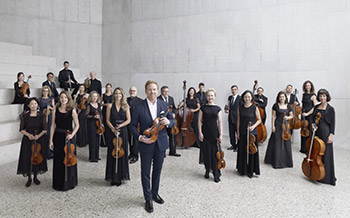
Violinist and music director Daniel Hope performs Vivaldi’s classic The Four Seasons and Max Richter’s The Four Seasons Recomposed on Sunday, November 10 at 2 p.m.
Zurich Chamber Orchestra: The Four Seasons
DID YOU KNOW . . . The Zurich Chamber Orchestra (Zürcher Kammerorchester; ZKO, German abbreviation) is a Swiss chamber orchestra based in Zurich? Edmond de Stoutz founded the ZKO in the aftermath of World War II and led its first concerts in 1945. He served as artistic leader and principal conductor of the ZKO until 1996. The core of the ZKO consists of 28 permanent members (strings, flute, oboe, horn, and harpsichord), with other sections (woodwinds, strings, brass, harp, and percussion) used as needed. It was the first Swiss orchestra to go on tour through the United States, first appearing in New York City in 1955.
DID YOU KNOW . . . British violinist Daniel Hope has toured the world as a virtuoso soloist for more than 25 years? Hope is celebrated for his musical versatility as well as his dedication to humanitarian causes. Winner of the 2015 European Cultural Prize for Music, whose previous recipients include Daniel Barenboim, Plácido Domingo, and the Berlin Philharmonic, Hope is easily considered “among the best in the world as well as the most thoughtful” (London Observer).
DID YOU KNOW . . . The Four Seasons (Italian: Le quattro stagioni) is a group of four violin concerti, by Italian composer Antonio Vivaldi, each of which gives musical expression to a season of the year? They were written around 1716-1717 and published in 1725 in Amsterdam. The Four Seasons is the best known of Vivaldi's works. Though three of the concerti are wholly original, the first, “Spring”, borrows motifs from a sinfonia in the first act of Vivaldi's contemporaneous opera Il Giustino. They were a revolution in musical conception: in them Vivaldi represented flowing creeks, singing birds (of different species, each specifically characterized), a shepherd and his barking dog, buzzing flies, storms, drunken dancers, hunting parties from both the hunters' and the prey's point of view, frozen landscapes, and warm winter fires.
DID YOU KNOW . . . Vivaldi published the concerti with accompanying sonnets (possibly written by the composer himself) that elucidated what his music was intended to evoke for each season? The concerti therefore stand as some of the earliest and most detailed examples of what would come to be called program music, i.e., music with a narrative element. Vivaldi took great pains to relate his music to the texts of the poems, translating the poetic lines themselves directly into the music on the page. For example, in the middle section of “Spring” when the goatherd sleeps, his barking dog can be heard in the viola section. The music is elsewhere similarly evocative of other natural sounds. Vivaldi divided each concerto into three movements (fast–slow–fast), and, likewise, each linked sonnet into three sections.
DID YOU KNOW . . . Max Richter has spent much of his life refining his approach to musical communication? In 2012, he released his first album for Deutsche Grammophon, Recomposed: Vivaldi · The Four Seasons. This was a collaboration with violinist Daniel Hope, conductor André de Ridder and the Konzerthaus Kammerorchester Berlin. "The Four Seasons is something we all carry around with us," says Richter, a German-born British composer. "It's just everywhere. In a way, we stop being able to hear it. So this project is about reclaiming this music for me personally, by getting inside it and rediscovering it for myself – and taking a new path through a well-known landscape. There are times I depart completely from the original, yes, but there are moments when it pokes through. I was pleased to discover that Vivaldi's music is very modular. It's pattern music, in a way, so there's a connection with the whole post-minimalist aesthetic I'm part of."
DID YOU KNOW . . . Daniel Hope commenting on Richter’s first movement of “Autumn” said, “He pulls the rhythm around, starts dropping quavers here and there. You end up with a rickety and slightly one-legged Vivaldi. It's incredibly funny. But even in poking fun at the original, there's always enormous respect."? The slow movement of “Winter” is another standout moment for Hope. "It's really out of this world," he says. "It's as if an alien has picked it up and pulled it through a time warp. It's really eerie: Max has kept Vivaldi's melody, but it's pulled apart by the ethereal harmonics underneath it."
DID YOU KNOW . . . In 2015 Richter wrote his acclaimed magnum opus Sleep, a concept album over eight hours long which explored the science of sleep? Extraordinarily, an hour-long version has now sold more than 100,000 copies, and, despite the complications implicit in its performance, the full-length work has been enjoyed live regularly around the world. Its audiences are being provided with beds instead of seats.
